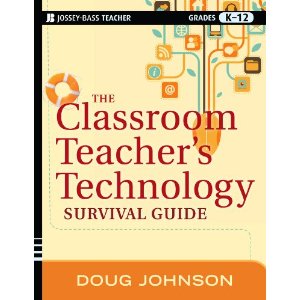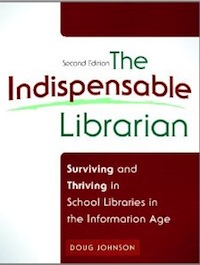13 Point Checklist
A 13 Point Library Media Program Checklist for School Principals
This is an updated version of the article “12 Point Library/Media Program Checklist for Building Administrators” that appeared in The Book Report, January 1996
Rapid changes in technology, learning research, and the library profession in the past ten years are creating a wide disparity in the effectiveness of school library media programs. Is your school’s library media program keeping current? The checklist below can be used to quickly evaluate your building’s program.
1. Professional staff and duties
• Does your library media center have the services of a fully licensed school library media specialist (SLMS)?
• Is that person fully engaged in professional duties? Is there a written job description for all library media personnel: clerical, technical, and professional?
• Does the SLMS understand and practice the roles of the SLMS as defined in Information Power II?
• Does the SLMS offer staff development opportunities in information literacy, information technologies, and integration of these skills into the content area?
• Is the SLMS an active member of a professional organization?
• Is the SLMS considered a full member of the teaching faculty?
2. Professional support
• Is sufficient clerical help available to the SLMS so that she/he can perform professional duties rather than clerical tasks?
• Is sufficient technical help available to the SLMS so that she/he can perform professional duties rather than technical tasks?
• Is there a district media supervisor, director, or department chair who is responsible for planning and leadership?
• Does the building principal and staff development team encourage the library media personnel to attend workshops, professional meetings, and conferences which will update their skills and knowledge?
3. Collection size and development
• Does the library media center’s book and audio visual collection meet the needs of the curriculum? Has a baseline print collection size been established? Is the collection well weeded?
• Are new materials chosen from professional selection sources and tied to the curriculum through collection mapping?
• Is a variety of media available that will address different learning styles?
• Have electronic and on-line resources been added to the collection when appropriate? Is there sufficient hardware for groups of students to take advantage of these resources?
4. Facilities
• Is the library media center located so it is readily accessible from all classrooms? Does it have an outside entrance so it can be used for community functions evenings and weekends?
• Does the library media center have an atmosphere conducive to learning with serviceable furnishings, instructional displays, and informational posters? Is the library media center carpeted with static-free carpet to reduce noise and protect electronic devices? Is the library media center climate-controlled so that materials and equipment will not be damaged by high heat and humidity, and so that it can be used for activities during the summer?
• Does the library media center contain a computer lab, multi-media workstations, and TV production facilities as well as general instructional areas, a story area (in elementary schools), and spaces for individuals to work?
• Is the library media center fully networked with voice, video and data lines in adequate quantities? Does the library media center serve as the “hub” of these information networks with routers, file servers, video head ends, etc. housed there?
5. Curriculum and integration
• Is the SLMS an active member of grade level and/or team planning groups?
• Is the SLMS an active member of content curriculum writing committees?
• Are library media center resources examined as a part of the content areas’ curriculum review cycle?
• Are library media and information technology skills taught as part of content areas rather than in isolation? Are the information literacy skills of evaluating, processing and communicating information being taught as well as accessing skills?
6. Resource-based teaching
• Does the SLMS with assistance from building and district administration promote teaching activities that go beyond the textbook?
• Is the SLMS used by teachers as an instructional design and authentic assessment resource?
• Does flexible scheduling in the building permit the SLMS to be a part of teaching teams with classroom teachers, rather than only covering teacher preparation time?
• Is there a clear set of information literacy and technology benchmarks written for all grade levels? Are these benchmarks assessed in a joint effort of the SLMS and classroom teacher? Are the results of these assessments shared with the student and parents?
7. Information technology
• Does the library media center give its users access to recent information technologies such as:
o computerized library catalogs and circulation systems
o access to a computerized union catalog of district holdings as well as access to the catalogs of public, academic and special libraries from which interlibrary loans can be made
o full on-line access to the Internet
o a wide variety of computerized reference tools like full text periodical indexes, electronic encyclopedias, magazine indexes electronic atlases, concordances, dictionaries, thesauruses, reader’s advisors and almanacs
o a wide variety of computerized productivity programs appropriate to student ability level such as word processors, multi-media and presentation programs, spreadsheets, databases, desktop publishing program, graphic creation programs, still and motion digital image editing software
o a wide range of educational computer programs including practices, simulations and tutorials
o production hardware such as multi-media computers, still and video digital cameras, scanners, and LCD projection devices.
o educational television programming and services
o access to desktop conferencing equipment opportunities
• Are the skills needed to use these resources being taught to and with teachers by the SLMS?
8. Telecommunications
• Is the school linked by a telecommunications network for distance learning opportunities for students? Are there interactive classrooms in the building?
• Does the library media program coordinate programming which can be aired on the local public access channel?
9. Networking & interlibrary loan
• Is your school a member of a regional multi-type system or library consortium?
• Does the SLMS use interlibrary loan to fill student and staff requests which cannot be met by building collections?
• Does the SLMS participate in cooperative planning opportunities with other schools, both locally and distant?
10. Planning/yearly goals
• Does the library media program have a district-wide set of long-range goals?
• Does the SLMS set yearly goals based on the long term goals that are tied directly to building and curriculum goals?
• Is a portion of the SLMS’s evaluation based on the achievement of the yearly goals?
• Is the library media program represented on the building technology planning committee? The district technology planning committee?
11. Budgeting
• Is the library media program budget zero or objective based? Is the budget tied to program goals?
• Does the SLMS write clear rationales for the materials, equipment, and supplies requested?
• Does the budget reflect both a maintenance and growth component for the program?
• Does the SLMS keep clear and accurate records of expenditures?
12. Policies/communications
• Are board policies concerning selection and reconsideration polices current and enforced? Is the staff aware of the doctrines of intellectual freedom and library user privacy?
• Does the district have a safe and acceptable use policy for Internet and technology use?
• Does the SLMS serve as an interpreter and advocate of copyright laws?
• Does the SLMS have a formal means of communicating the goals and services of the program to the students, staff, administration, and community?
13. Evaluation
• Does the district regularly evaluate the library media program using external teams of evaluators as part of any accreditation process?
• Does the SLMS determine and report ways which show the goals and objectives of the program are being met and are helping meet the building and district goals?
• Do all new initiatives involving the library media and technology program have an evaluation component?
• Do the SLMS and school participate in formal studies conducted by academic researchers when requested?





Reader Comments (3)
Rather useful! Thanks for sharing knowledge and wisdom. A good question enables information, more than a thousand answers to an irrelevant point :)
Thanks for your comment, Maria. Always nice to know that something one has written has been useful.
Doug
Under Collection size, you ask if there has been a baseline set for the size of the print collection. I'm having trouble finding guidelines for this. Can you please point me in the right direction?
Thanks!